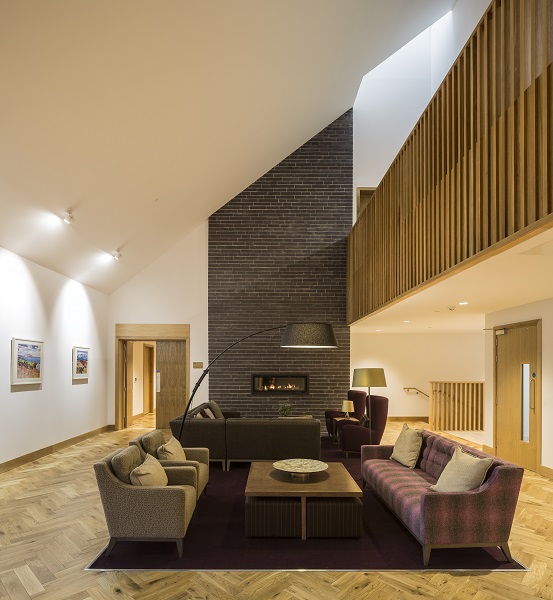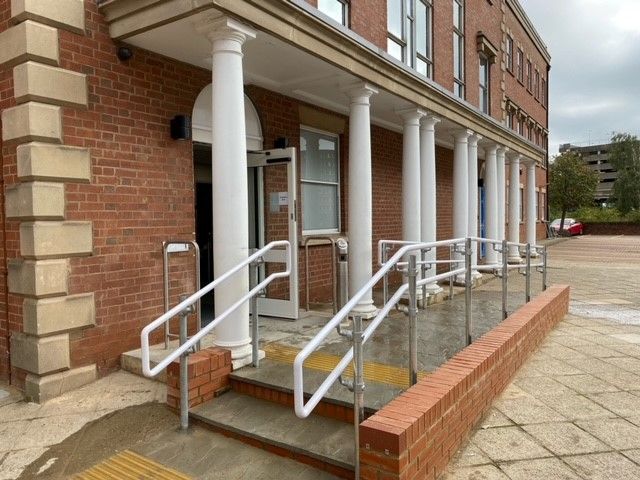Welsh
Slate has been specified for its aesthetics and robustness, for the roof and
innovative cladding of a ground-breaking new hospice.
The £21
million Prince and Princess of Wales Hospice in Glasgow's Bellahouston Park
features Welsh Slate's Penrhyn Heather Blue Celtic grade 270mm x 180mm roof
slates which are complemented by a cladding veneer of the same colour over a
total of 1,400m2 of the outer façade layer of ‘protective' eaves and
bedroom terraces.
This complements the
buff-coloured Petersen brickwork and bronze-coloured metal panels used on the
inner layer of the façade. Projecting eaves features in the same slate are also
utilised on the northern and southern gable facades to express the prominent
building ends. In addition, Welsh Slate Penrhyn Heather Blue walling features
on a large internal chimney hearth.
The
Welsh Slate materials were specified, for the first time, by Ryder Architecture
for the 5,840m2 building which comprises a 16-bed in-patients' unit
including young adults' bedrooms, with associated support and family space
including large kitchens, day services and out-patients' units, educational
area, and administration and clinical offices over three storeys.

The
Scandinavian-inspired hospice is the first in the UK to follow the Sengetun
(meaning bed courtyard) model of care which promotes a home-from-home
environment that also allows patients privacy when required. The model is based
on research that suggests the aesthetic deign of a healthcare building has a
measurable impact on patients' wellbeing.
Ryder and main
contractor Balfour Beatty delivered a purpose-built, innovative and exemplary
palliative care facility that delivers form as well as function in response to
the brief which called for a warm, welcoming and non-clinical entrance and
interior in a quality environment with interior and exterior materiality.
The hospice supports
1,200 patients and their families from a geographical area that spans Glasgow,
East Renfrewshire, Cambuslang and Rutherglen, with a population of about
345,000. With something of a civic presence, it is set in 7.5 acres of parkland
on a site gifted to the charity by Glasgow City Council, with a form that
mediates between the city it serves and its parkland setting.
After
more than 30 years of adapting and adjusting in the old hospice building in
Carlton Place, the new building enables the organisation to expand its services
and offer 21st Century palliative care to young people over 16 years
for the first time.

To negate the
potential sprawl of the complex brief and adjacencies, the accommodation was
reduced to four interconnected villas that reduce the overall perception of the
massing to a human scale.
Project architect
Alastair Forbes said: "The building envelope has been designed with a
number of key aims in mind. The primary aim is to provide a building of
dignified quality commensurate with the importance of the site and the building
use, and a robust building that requires, wherever possible, minimal
maintenance.
"The quality of
the materials proposed is critical to the success of the project and the manner
in which the materials are detailed is significant in providing suitable scale
and presence for the building on the site. It has to address its context successfully,
both in terms of the immediate site of Bellahouston Park and also the important
Hazelwood and Dumbreck Conservation Areas directly adjacent."
He added: "The
protective nature of the building is realised in a ‘loggia' or ‘veranda' that
runs around the whole building, providing a transition zone between the
interior spaces and the surrounding landscape. This is an integral space for
patient use and inhabitation.
"Slate is used
for the external skin of the building which reinforces the protective nature of
the building envelope. One senses the physical weight of the building on the
outside at the same time as the ethereal quality of the light-filled interior
spaces. These protective elements differ in density and permeability depending
on the interior functions, sunlight and the site conditions.
"The
‘purple/heather' tones of the Penrhyn slate were essential in linking the
landscape and building interior whilst avoiding an overtly dark-coloured
building that would not be suitable for the building's function."
The
Welsh Slate roof slates were laid with 50mm x 3.35mm copper clout nails over
timber sarking boards with mitred slate hips to a 38° pitch over eight months
and 1,535m2 by specialist sub-contractor Braisby Roofing, while
the cladding system was devised and installed over 12 months by Stonescreen,
specialists in natural stone rainscreen systems.
The company
custom-designed the support structure and frames to hold the slate composite
panels which used Stonescreen Aerolite© technology as the base. This is
engineered with a combination of cellular glass reinforced with layers of glass
fibre to produce a very high-strength/low-weight substrate which is typically
faced with a thin veneer of natural or artificial stone.

In this case, the
Welsh Slate was supplied to Stonescreen as more than 200 blocks weighing over
half a tonne each and varying in length from 1,000mm to 1,600mm, in width from
500mm to 600mm and in depth from 200mm to 450mm. These were semi-processed - sawn
both sides with the ends left natural.
The blocks were then
cut to 20mm and foam glass material glued to each side of the slate. This was
then cut through the middle using a band saw and flamed. Cuts of 3mm were
achieved which made the final cladding panel 8.5mm Welsh Slate and 40mm foam
glass.
Stonescreen director
Gary O'Connor said: "The design and construction of the support structure
was the most complex part of the cladding works. Attaching the cladding panels
was relatively straightforward."
Alastair said
"The building fabric, wherever possible, has been used to enhance the
environmental performance of the building which had to demonstrate low energy
use and value for money over a lifecycle costing.
"The external
walls and windows had to meet the standards set down in the revised Section 6
of the Scottish Building Standards, including standards for airtightness. In
the detailed specification of the materials for the building, consideration was
given to green issues such as low embodied energy, responsible sourcing, and
sustainability/environmental performance.
Braisby Roofing's
managing director William Braisby said: "The length of the roof slope was
a challenge and there was a lot of interface with other traders on site -
joiners and single-ply roofers for example - but apart from that the project
was straightforward. Both we and the client were extremely happy with the
slate. It looks really good."
Welsh Slate commercial
director Michael Hallé said: "The cladding system used on this project is
the first time a composite panel with a Welsh Slate veneer has been used. The
overall appearance of the Welsh Slate on the project is stunning and it sits
beautifully within the environment."






















